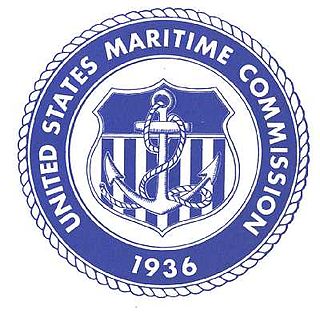SS City of Flint, a Hog Islander freighter built by American International Shipbuilding at the Hog Island Shipyard, Philadelphia for the United States Shipping Board (USSB), Emergency Fleet Corporation. City of Flint was named to honor the citizens of Flint, Michigan for their effort in Liberty Loan drives during World War I.

The United States Maritime Commission (MARCOM) was an independent executive agency of the U.S. federal government that was created by the Merchant Marine Act of 1936, which was passed by Congress on June 29, 1936, and was abolished on May 24, 1950. The commission replaced the United States Shipping Board which had existed since World War I. It was intended to formulate a merchant shipbuilding program to design and build five hundred modern merchant cargo ships to replace the World War I vintage vessels that comprised the bulk of the United States Merchant Marine, and to administer a subsidy system authorized by the Act to offset the cost differential between building in the U.S. and operating ships under the American flag. It also formed the United States Maritime Service for the training of seagoing ship's officers to man the new fleet.
Mopang was a steam cargo ship built in 1919 by Submarine Boat Company of Newark for the United States Shipping Board (USSB) as part of the wartime shipbuilding program of the Emergency Fleet Corporation (EFC) to restore the nation's Merchant Marine. The vessel was chiefly employed on the East Coast and Gulf to Europe routes throughout her short career. In June 1921 the vessel struck a mine while attempting to enter the Burgas Bay and sank without any casualties.

SS West Hosokie was a steel–hulled cargo ship built in 1918 as part of the World War I emergency wartime shipbuilding program organized by the United States Shipping Board.
SS Canadian Mariner was a freighter built by Halifax Shipyards Ltd in 1920. She was the first steel ship built in Halifax and was used as a general cargo ship until she was sunk in the Pacific in 1942.

Corvus was a steam cargo ship built in 1919 by Columbia River Shipbuilding Company of Portland for the United States Shipping Board as part of the wartime shipbuilding program of the Emergency Fleet Corporation (EFC) to restore the nation's Merchant Marine. The freighter was operated on international and domestic routes through 1944. Early in 1945 she was transferred to Soviet Union as part of lend-lease program and renamed Uzbekistan. After several months of operation, the freighter was rammed by another vessel on 31 May 1945 and was beached to avoid sinking. She was subsequently raised and towed to Portland where she was scrapped in 1946.
William O'Brien was a steam cargo ship built in 1914–1915 by New York Shipbuilding Company of Camden for the Carpenter–O'Brien Lumber Company of Delaware. The vessel was extensively employed on East Coast to Europe routes during her career and foundered on one of her regular trips in April 1920.

SS Cynthia Olson was a cargo ship originally built in Wisconsin in 1918 as the SS Coquina. Renamed in 1940, in August 1941 she was chartered by the US Army to transport supplies to Hawaii. While in passage between Tacoma, Washington and Honolulu on December 7, she was intercepted by the Japanese submarine I-26, which sank her with gunfire. Although the commander of the submarine ensured that all of the crew had escaped into boats, none of them was ever found. Cynthia Olson was the first United States Merchant Marine vessel to be sunk after the entry of the United States into World War II.
SS Managua was a Nicaraguan Cargo ship that the German submarine U-67 torpedoed on 16 June 1942 in the Straits of Florida while she was travelling from Charleston, South Carolina, United States to Havana, Cuba with a cargo of Potash. The ship was built as Glorieta, a Design 1049 ship in 1919, operated by the United States Shipping Board (USSB) until sold to the Munson Steamship Line in 1920 and renamed Munisla. The ship was sold foreign to a Honduran company, Garcia, in 1937 and renamed Neptuno. In 1941 the ship was re-flagged in Nicaragua with the name Managua.
SSCapillo was a Design 1022 cargo ship built for the United States Shipping Board immediately after World War I.
Suremico was a Design 1023 cargo ship built for the United States Shipping Board (USSB) immediately after World War I. She was later named the Nisqually and converted into a barge and later a scow. She was bombed and sunk during the Battle of Wake Island.
SSSuedco was a Design 1023 cargo ship built for the United States Shipping Board immediately after World War I.
SSSuboatco was a Design 1023 cargo ship built for the United States Shipping Board immediately after World War I.
SSSuportco was a Design 1023 cargo ship built for the United States Shipping Board immediately after World War I.
SSCambridge was a Design 1023 cargo ship built for the United States Shipping Board immediately after World War I.
SSKehuku was a Design 1031 tanker ship built for the United States Shipping Board immediately after World War I.
SSCassimir was a Design 1022 cargo ship built for the United States Shipping Board immediately after World War I.
SSCarrabulle was a Design 1022 cargo ship built for the United States Shipping Board immediately after World War I.
SSCatahoula was a Design 1022 cargo ship built for the United States Shipping Board immediately after World War I.
SSComol Cuba was a Design 1022 cargo ship built for the United States Shipping Board immediately after World War I. Converted to a tanker, she spent most of her career transporting molasses, a byproduct of sugar refining, to the United States. During World War II, she transported petroleum before returning to the private sector.



